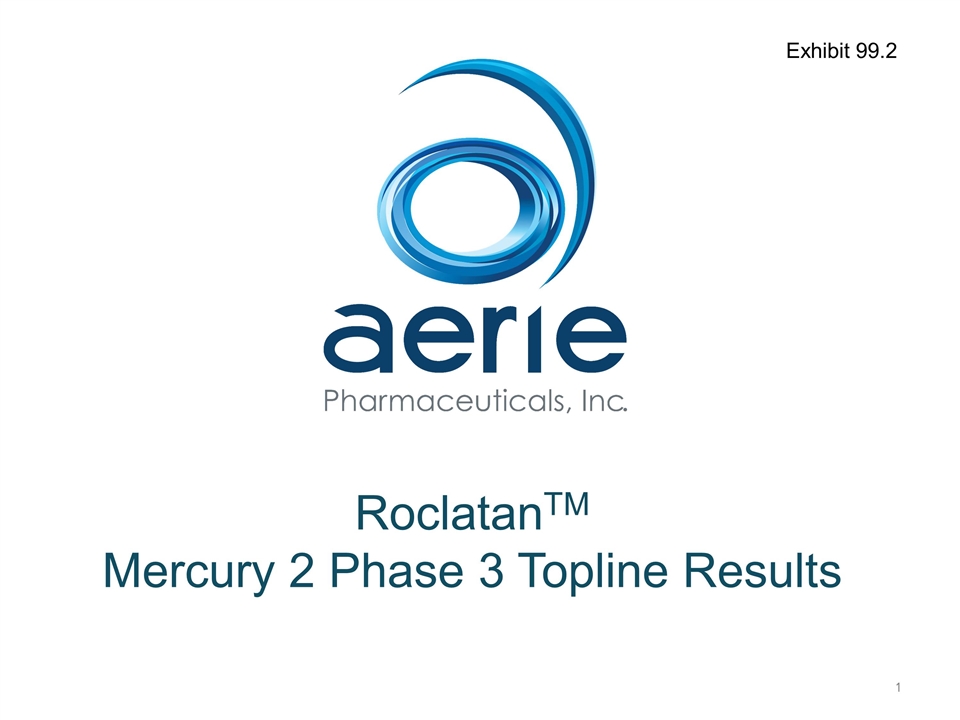
RoclatanTM Mercury 2 Phase 3 Topline Results Exhibit 99.2
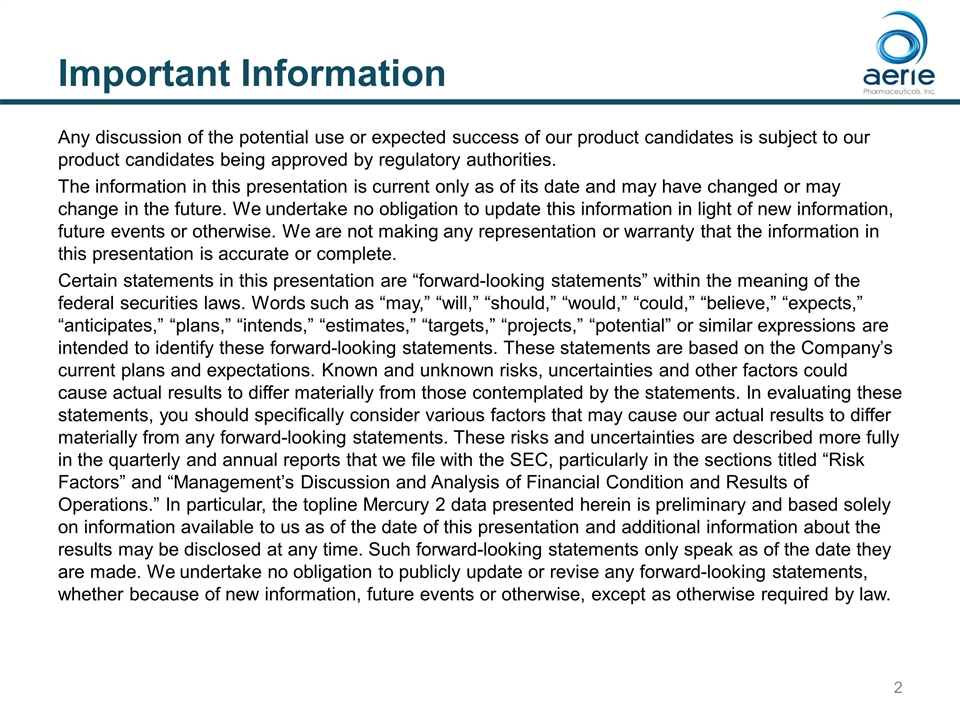
Important Information Any discussion of the potential use or expected success of our product candidates is subject to our product candidates being approved by regulatory authorities. The information in this presentation is current only as of its date and may have changed or may change in the future. We undertake no obligation to update this information in light of new information, future events or otherwise. We are not making any representation or warranty that the information in this presentation is accurate or complete. Certain statements in this presentation are “forward-looking statements” within the meaning of the federal securities laws. Words such as “may,” “will,” “should,” “would,” “could,” “believe,” “expects,” “anticipates,” “plans,” “intends,” “estimates,” “targets,” “projects,” “potential” or similar expressions are intended to identify these forward-looking statements. These statements are based on the Company’s current plans and expectations. Known and unknown risks, uncertainties and other factors could cause actual results to differ materially from those contemplated by the statements. In evaluating these statements, you should specifically consider various factors that may cause our actual results to differ materially from any forward-looking statements. These risks and uncertainties are described more fully in the quarterly and annual reports that we file with the SEC, particularly in the sections titled “Risk Factors” and “Management’s Discussion and Analysis of Financial Condition and Results of Operations.” In particular, the topline Mercury 2 data presented herein is preliminary and based solely on information available to us as of the date of this presentation and additional information about the results may be disclosed at any time. Such forward-looking statements only speak as of the date they are made. We undertake no obligation to publicly update or revise any forward-looking statements, whether because of new information, future events or otherwise, except as otherwise required by law.
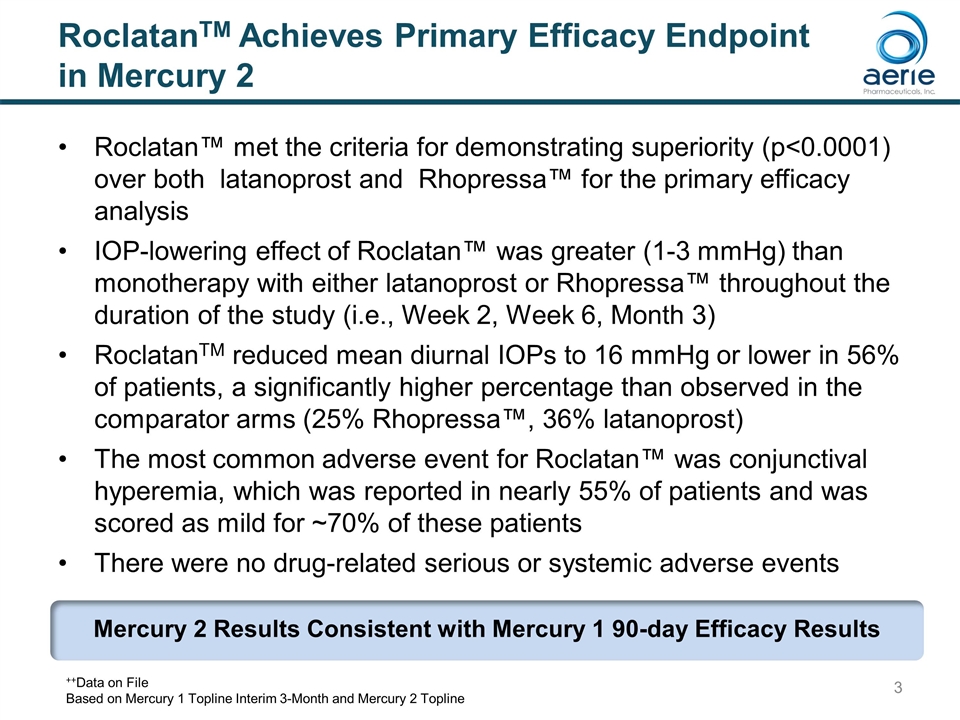
Roclatan™ met the criteria for demonstrating superiority (p<0.0001) over both latanoprost and Rhopressa™ for the primary efficacy analysis IOP-lowering effect of Roclatan™ was greater (1-3 mmHg) than monotherapy with either latanoprost or Rhopressa™ throughout the duration of the study (i.e., Week 2, Week 6, Month 3) RoclatanTM reduced mean diurnal IOPs to 16 mmHg or lower in 56% of patients, a significantly higher percentage than observed in the comparator arms (25% Rhopressa™, 36% latanoprost) The most common adverse event for Roclatan™ was conjunctival hyperemia, which was reported in nearly 55% of patients and was scored as mild for ~70% of these patients There were no drug-related serious or systemic adverse events RoclatanTM Achieves Primary Efficacy Endpoint in Mercury 2 Mercury 2 Results Consistent with Mercury 1 90-day Efficacy Results ++Data on File Based on Mercury 1 Topline Interim 3-Month and Mercury 2 Topline
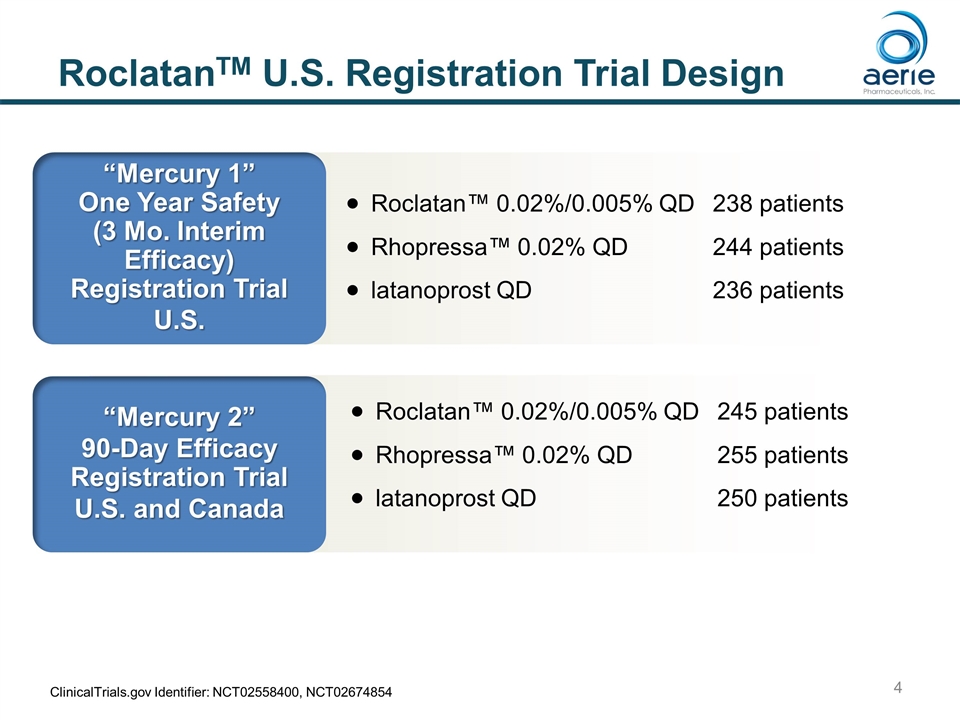
RoclatanTM U.S. Registration Trial Design ClinicalTrials.gov Identifier: NCT02558400, NCT02674854 “Mercury 1” One Year Safety (3 Mo. Interim Efficacy) Registration Trial U.S. “Mercury 2” 90-Day Efficacy Registration Trial U.S. and Canada Roclatan™ 0.02%/0.005% QD 245 patients Rhopressa™ 0.02% QD 255 patients latanoprost QD 250 patients Roclatan™ 0.02%/0.005% QD 238 patients Rhopressa™ 0.02% QD 244 patients latanoprost QD 236 patients
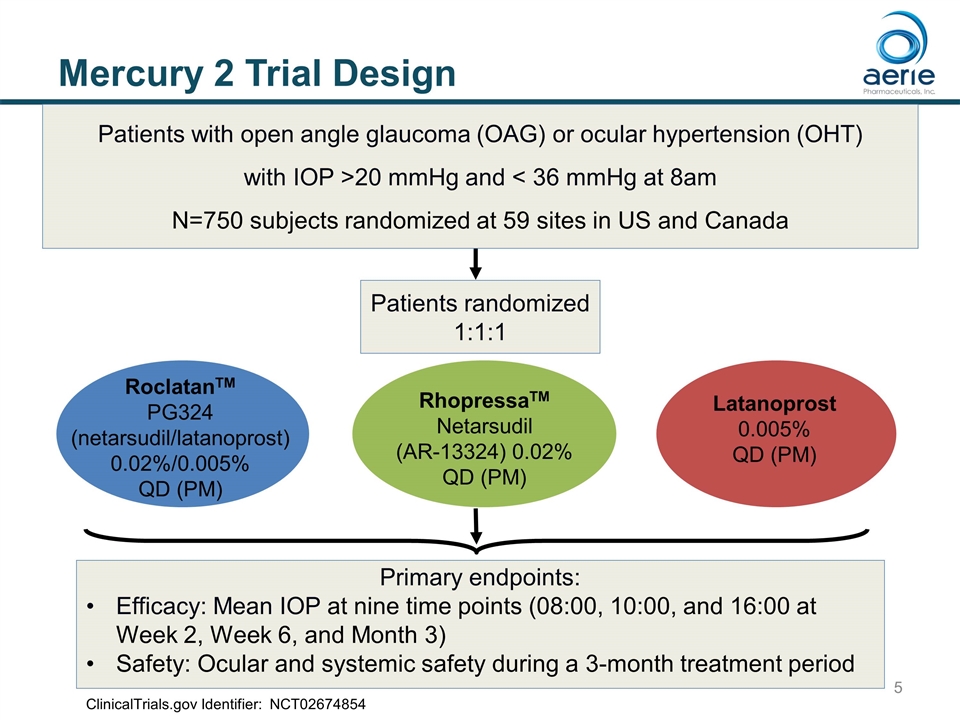
Mercury 2 Trial Design Patients randomized 1:1:1 Primary endpoints: Efficacy: Mean IOP at nine time points (08:00, 10:00, and 16:00 at Week 2, Week 6, and Month 3) Safety: Ocular and systemic safety during a 3‑month treatment period ClinicalTrials.gov Identifier: NCT02674854 Patients with open angle glaucoma (OAG) or ocular hypertension (OHT) with IOP >20 mmHg and < 36 mmHg at 8am N=750 subjects randomized at 59 sites in US and Canada RoclatanTM PG324 (netarsudil/latanoprost) 0.02%/0.005% QD (PM) RhopressaTM Netarsudil (AR-13324) 0.02% QD (PM) Latanoprost 0.005% QD (PM)
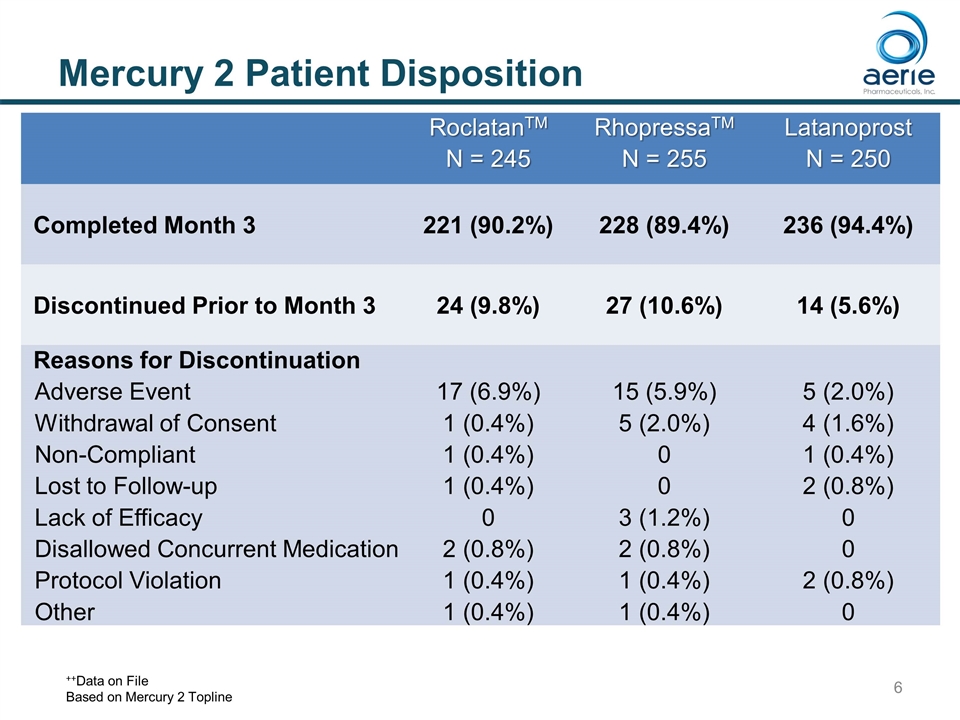
Mercury 2 Patient Disposition Conjunctival hyperemia was most common AE leading to discontinuation in RoclatanTM QD RoclatanTM N = 245 RhopressaTM N = 255 Latanoprost N = 250 Completed Month 3 221 (90.2%) 228 (89.4%) 236 (94.4%) Discontinued Prior to Month 3 24 (9.8%) 27 (10.6%) 14 (5.6%) Reasons for Discontinuation Adverse Event Withdrawal of Consent Non-Compliant Lost to Follow-up Lack of Efficacy Disallowed Concurrent Medication Protocol Violation Other 17 (6.9%) 1 (0.4%) 1 (0.4%) 1 (0.4%) 0 2 (0.8%) 1 (0.4%) 1 (0.4%) 15 (5.9%) 5 (2.0%) 0 0 3 (1.2%) 2 (0.8%) 1 (0.4%) 1 (0.4%) 5 (2.0%) 4 (1.6%) 1 (0.4%) 2 (0.8%) 0 0 2 (0.8%) 0 ++Data on File Based on Mercury 2 Topline
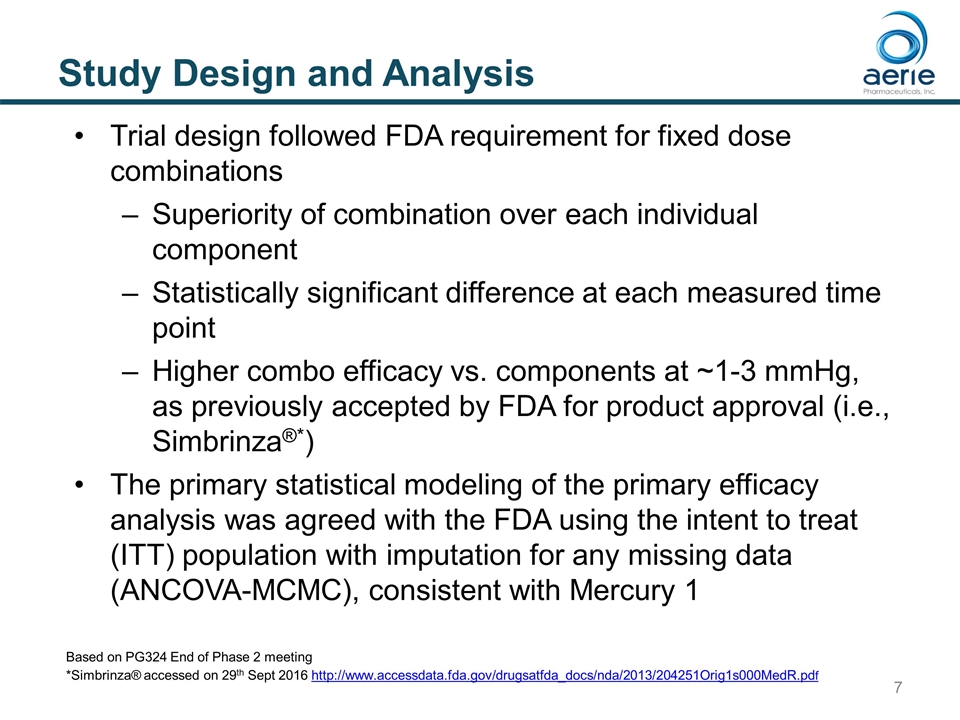
Study Design and Analysis Trial design followed FDA requirement for fixed dose combinations Superiority of combination over each individual component Statistically significant difference at each measured time point Higher combo efficacy vs. components at ~1-3 mmHg, as previously accepted by FDA for product approval (i.e., Simbrinza®*) The primary statistical modeling of the primary efficacy analysis was agreed with the FDA using the intent to treat (ITT) population with imputation for any missing data (ANCOVA-MCMC), consistent with Mercury 1 Based on PG324 End of Phase 2 meeting *Simbrinza® accessed on 29th Sept 2016 http://www.accessdata.fda.gov/drugsatfda_docs/nda/2013/204251Orig1s000MedR.pdf
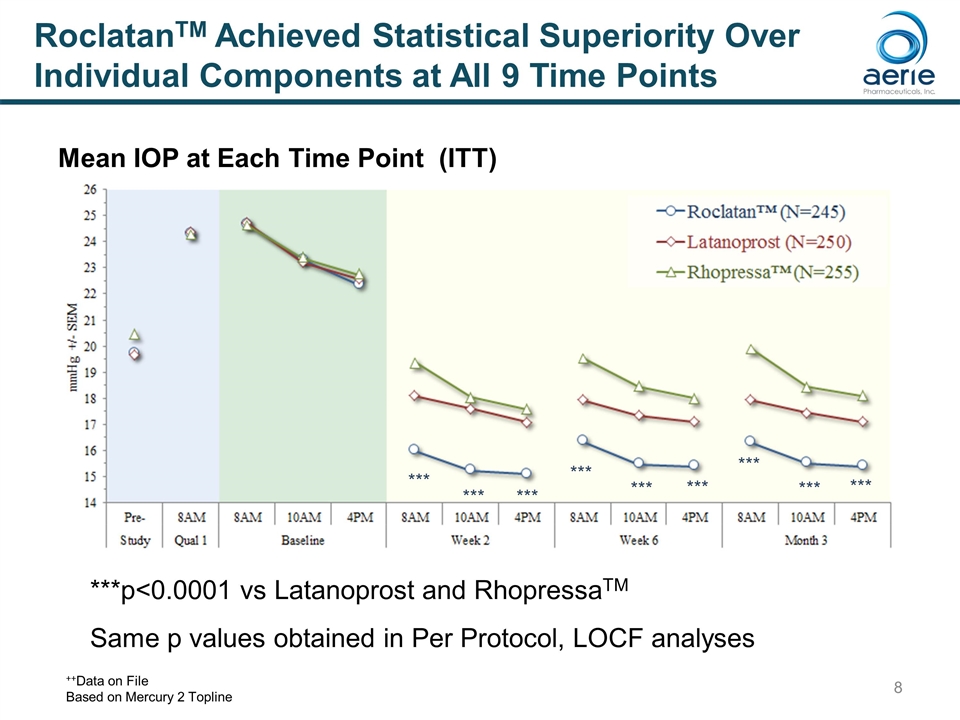
RoclatanTM Achieved Statistical Superiority Over Individual Components at All 9 Time Points Mean IOP at Each Time Point (ITT) ***p<0.0001 vs Latanoprost and RhopressaTM Same p values obtained in Per Protocol, LOCF analyses *** *** *** *** *** *** *** *** *** ++Data on File Based on Mercury 2 Topline
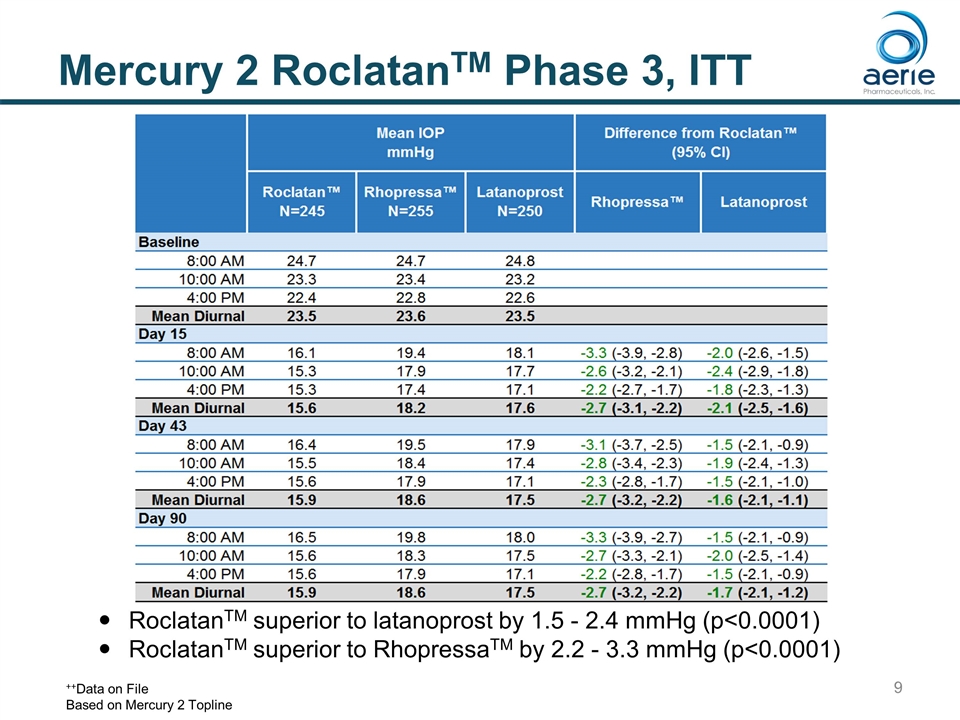
Mercury 2 RoclatanTM Phase 3, ITT RoclatanTM superior to latanoprost by 1.5 - 2.4 mmHg (p<0.0001) RoclatanTM superior to RhopressaTM by 2.2 - 3.3 mmHg (p<0.0001) ++Data on File Based on Mercury 2 Topline
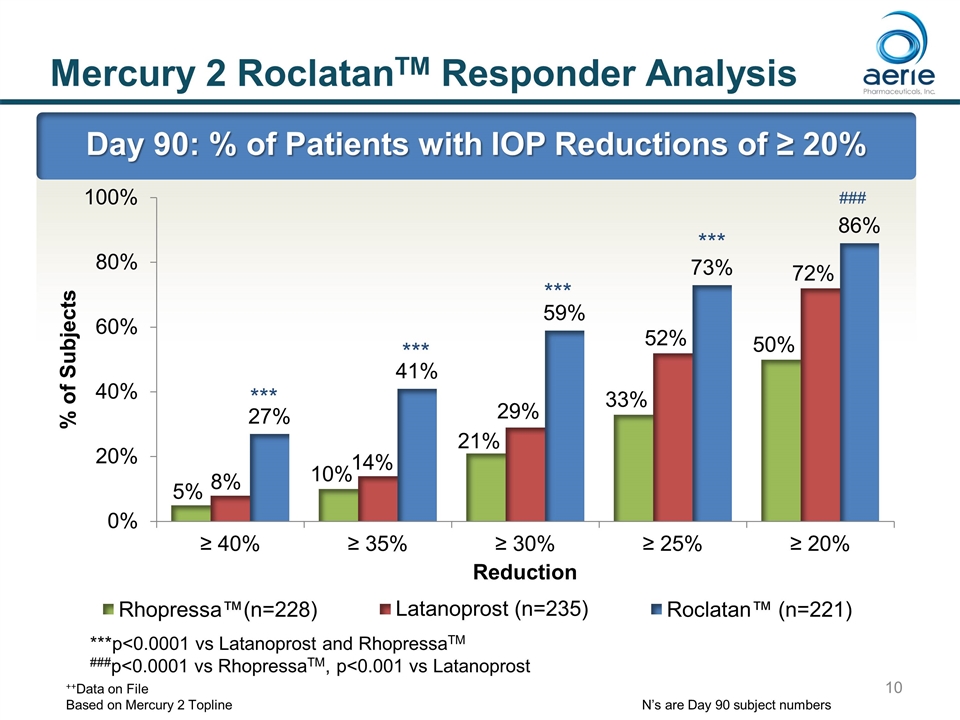
Mercury 2 RoclatanTM Responder Analysis Replace Day 90: % of Patients with IOP Reductions of ≥ 20% ***p<0.0001 vs Latanoprost and RhopressaTM ###p<0.0001 vs RhopressaTM, p<0.001 vs Latanoprost *** *** *** ++Data on File Based on Mercury 2 ToplineN’s are Day 90 subject numbers
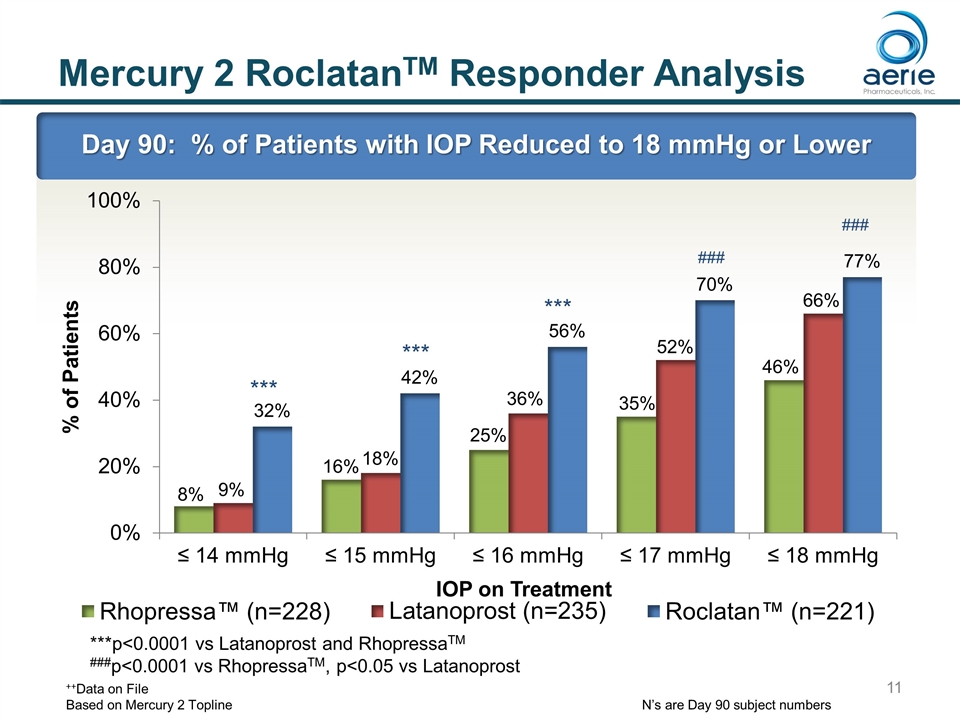
Mercury 2 RoclatanTM Responder Analysis Day 90: % of Patients with IOP Reduced to 18 mmHg or Lower *** *** *** ***p<0.0001 vs Latanoprost and RhopressaTM ###p<0.0001 vs RhopressaTM, p<0.05 vs Latanoprost ++Data on File Based on Mercury 2 ToplineN’s are Day 90 subject numbers
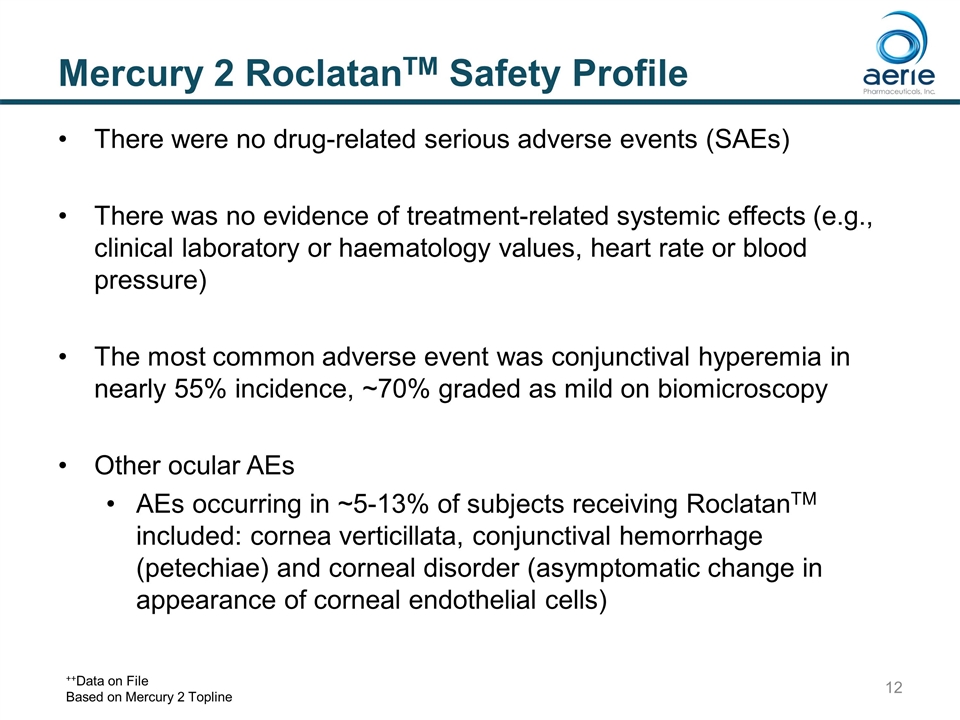
Mercury 2 RoclatanTM Safety Profile There were no drug-related serious adverse events (SAEs) There was no evidence of treatment-related systemic effects (e.g., clinical laboratory or haematology values, heart rate or blood pressure) The most common adverse event was conjunctival hyperemia in nearly 55% incidence, ~70% graded as mild on biomicroscopy Other ocular AEs AEs occurring in ~5-13% of subjects receiving RoclatanTM included: cornea verticillata, conjunctival hemorrhage (petechiae) and corneal disorder (asymptomatic change in appearance of corneal endothelial cells) ++Data on File Based on Mercury 2 Topline
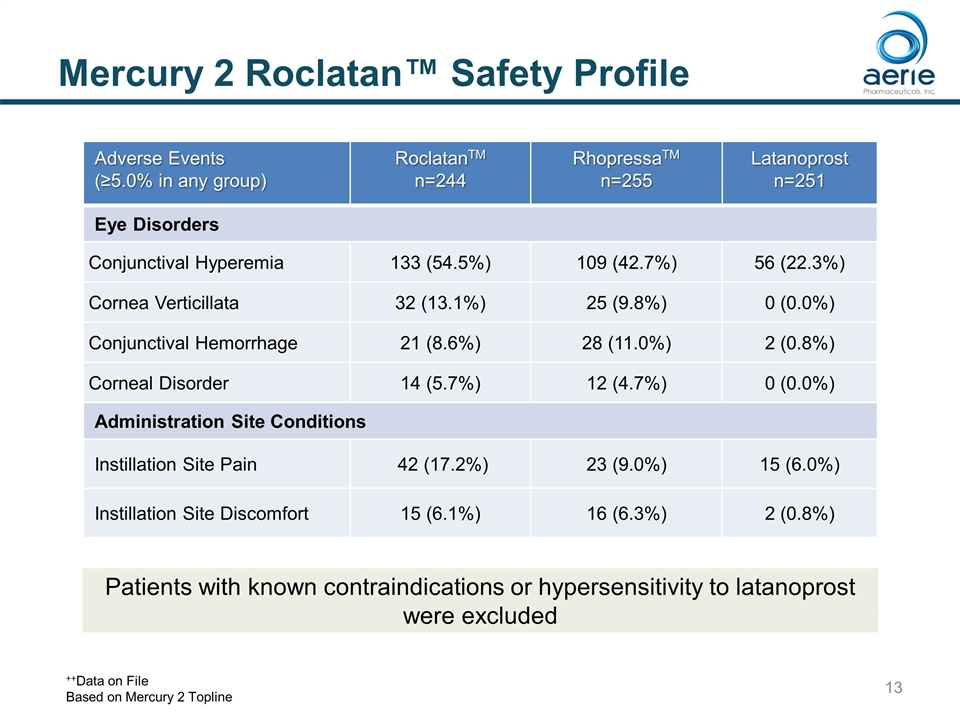
Mercury 2 Roclatan™ Safety Profile Adverse Events (≥5.0% in any group) RoclatanTM n=244 RhopressaTM n=255 Latanoprost n=251 Eye Disorders Conjunctival Hyperemia 133 (54.5%) 109 (42.7%) 56 (22.3%) Cornea Verticillata 32 (13.1%) 25 (9.8%) 0 (0.0%) Conjunctival Hemorrhage 21 (8.6%) 28 (11.0%) 2 (0.8%) Corneal Disorder 14 (5.7%) 12 (4.7%) 0 (0.0%) Administration Site Conditions Instillation Site Pain 42 (17.2%) 23 (9.0%) 15 (6.0%) Instillation Site Discomfort 15 (6.1%) 16 (6.3%) 2 (0.8%) Patients with known contraindications or hypersensitivity to latanoprost were excluded 3 ++Data on File Based on Mercury 2 Topline
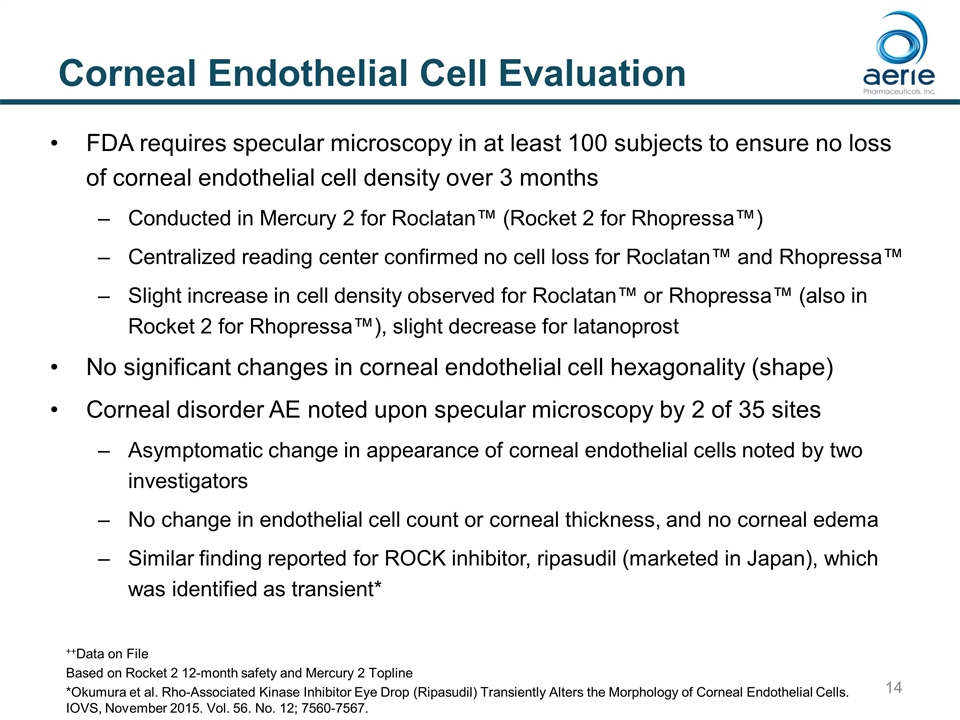
Corneal Endothelial Cell Evaluation FDA requires specular microscopy in at least 100 subjects to ensure no loss of corneal endothelial cell density over 3 months Conducted in Mercury 2 for Roclatan™ (Rocket 2 for Rhopressa™) Centralized reading center confirmed no cell loss for Roclatan™ and Rhopressa™ Slight increase in cell density observed for Roclatan™ or Rhopressa™ (also in Rocket 2 for Rhopressa™), slight decrease for latanoprost No significant changes in corneal endothelial cell hexagonality (shape) Corneal disorder AE noted upon specular microscopy by 2 of 35 sites Asymptomatic change in appearance of corneal endothelial cells noted by two investigators No change in endothelial cell count or corneal thickness, and no corneal edema Similar finding reported for ROCK inhibitor, ripasudil (marketed in Japan), which was identified as transient* ++Data on File Based on Rocket 2 12-month safety and Mercury 2 Topline *Okumura et al. Rho-Associated Kinase Inhibitor Eye Drop (Ripasudil) Transiently Alters the Morphology of Corneal Endothelial Cells. IOVS, November 2015. Vol. 56. No. 12; 7560-7567.
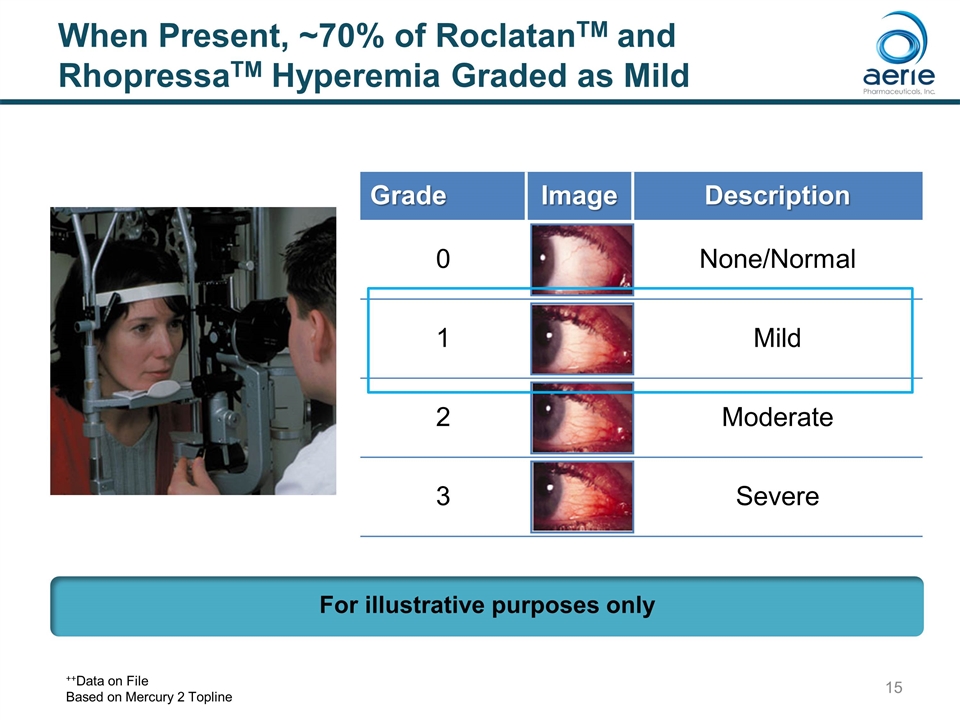
When Present, ~70% of RoclatanTM and RhopressaTM Hyperemia Graded as Mild For illustrative purposes only Grade Image Description 0 None/Normal 1 Mild 2 Moderate 3 Severe ++Data on File Based on Mercury 2 Topline
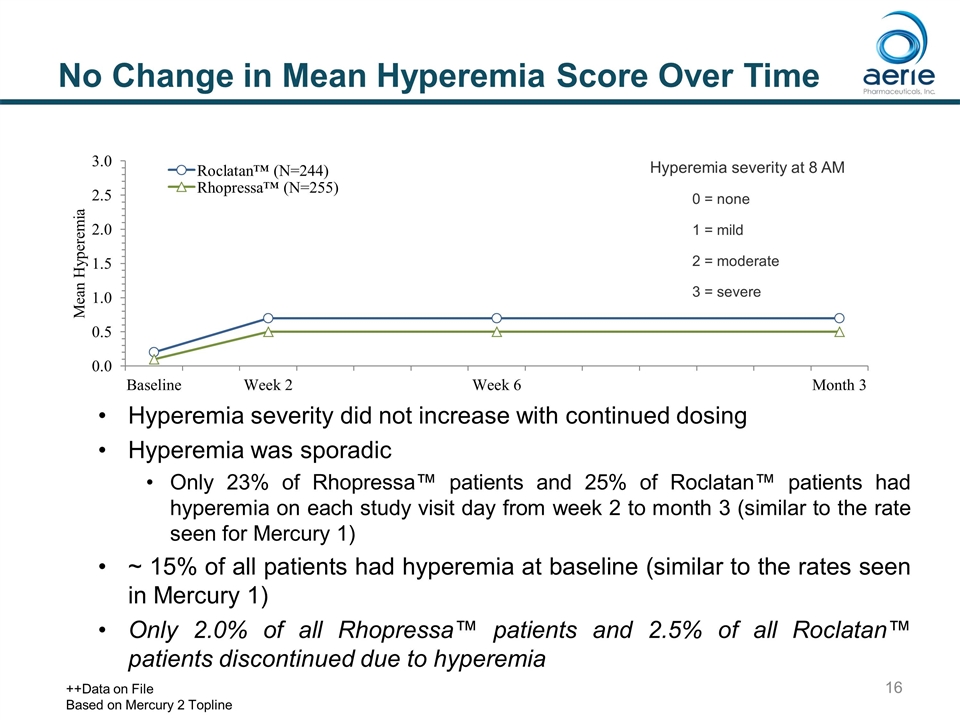
No Change in Mean Hyperemia Score Over Time Hyperemia severity did not increase with continued dosing Hyperemia was sporadic Only 23% of Rhopressa™ patients and 25% of Roclatan™ patients had hyperemia on each study visit day from week 2 to month 3 (similar to the rate seen for Mercury 1) ~ 15% of all patients had hyperemia at baseline (similar to the rates seen in Mercury 1) Only 2.0% of all Rhopressa™ patients and 2.5% of all Roclatan™ patients discontinued due to hyperemia Hyperemia severity at 8 AM 0 = none 1 = mild 2 = moderate 3 = severe ++Data on File Based on Mercury 2 Topline
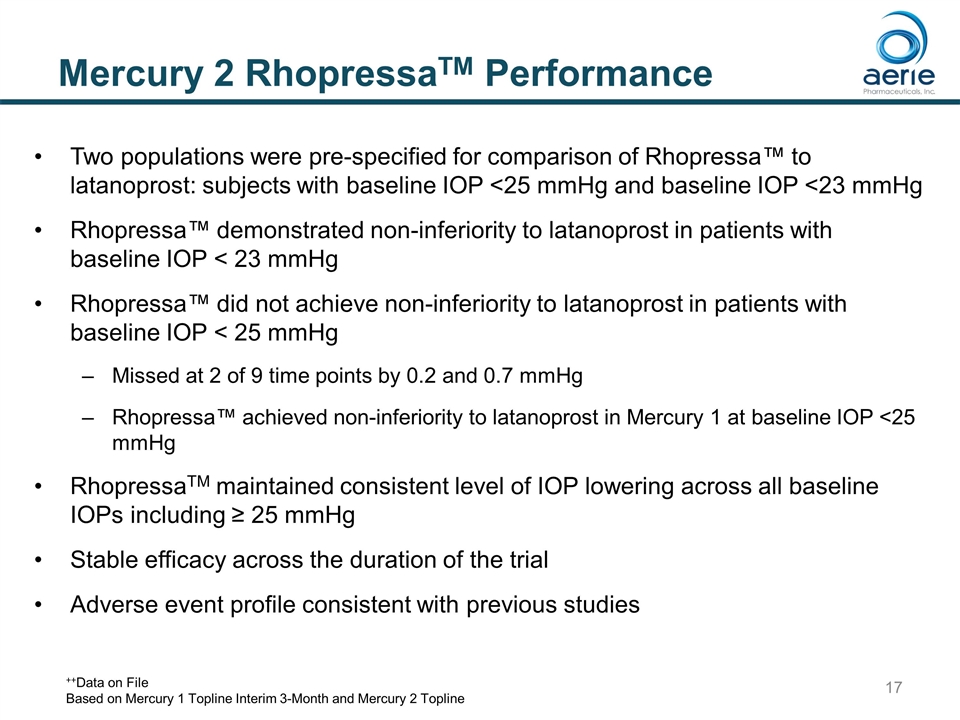
Mercury 2 RhopressaTM Performance Two populations were pre-specified for comparison of Rhopressa™ to latanoprost: subjects with baseline IOP <25 mmHg and baseline IOP <23 mmHg Rhopressa™ demonstrated non-inferiority to latanoprost in patients with baseline IOP < 23 mmHg Rhopressa™ did not achieve non-inferiority to latanoprost in patients with baseline IOP < 25 mmHg Missed at 2 of 9 time points by 0.2 and 0.7 mmHg Rhopressa™ achieved non-inferiority to latanoprost in Mercury 1 at baseline IOP <25 mmHg RhopressaTM maintained consistent level of IOP lowering across all baseline IOPs including ≥ 25 mmHg Stable efficacy across the duration of the trial Adverse event profile consistent with previous studies ++Data on File Based on Mercury 1 Topline Interim 3-Month and Mercury 2 Topline
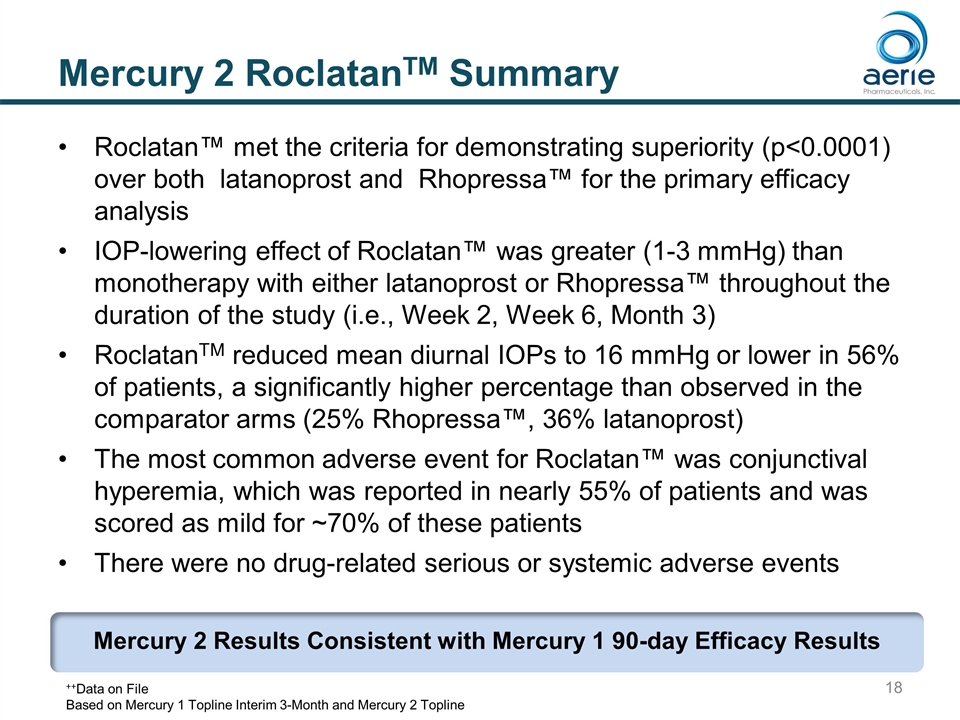
Roclatan™ met the criteria for demonstrating superiority (p<0.0001) over both latanoprost and Rhopressa™ for the primary efficacy analysis IOP-lowering effect of Roclatan™ was greater (1-3 mmHg) than monotherapy with either latanoprost or Rhopressa™ throughout the duration of the study (i.e., Week 2, Week 6, Month 3) RoclatanTM reduced mean diurnal IOPs to 16 mmHg or lower in 56% of patients, a significantly higher percentage than observed in the comparator arms (25% Rhopressa™, 36% latanoprost) The most common adverse event for Roclatan™ was conjunctival hyperemia, which was reported in nearly 55% of patients and was scored as mild for ~70% of these patients There were no drug-related serious or systemic adverse events Mercury 2 RoclatanTM Summary Mercury 2 Results Consistent with Mercury 1 90-day Efficacy Results ++Data on File Based on Mercury 1 Topline Interim 3-Month and Mercury 2 Topline
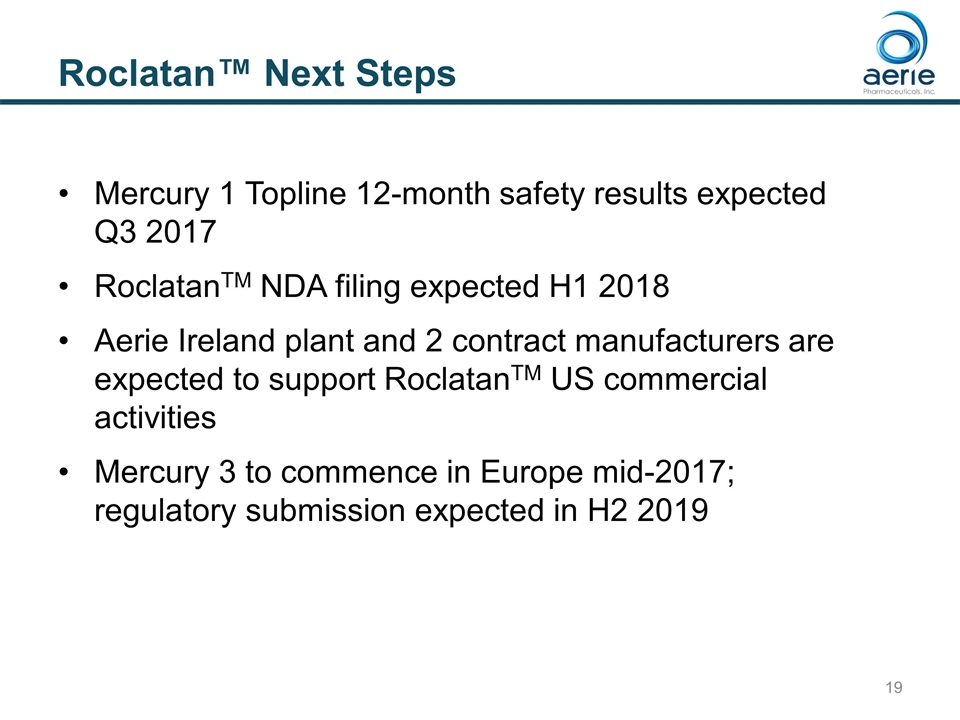
Roclatan™ Next Steps Mercury 1 Topline 12-month safety results expected Q3 2017 RoclatanTM NDA filing expected H1 2018 Aerie Ireland plant and 2 contract manufacturers are expected to support RoclatanTM US commercial activities Mercury 3 to commence in Europe mid-2017; regulatory submission expected in H2 2019


















